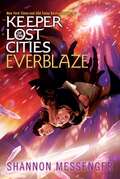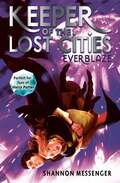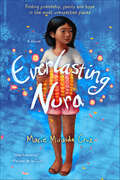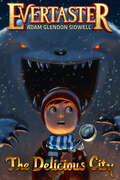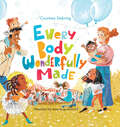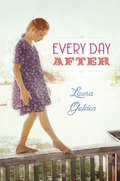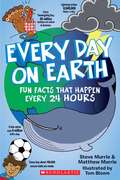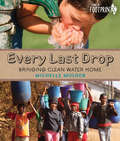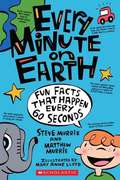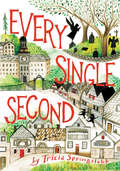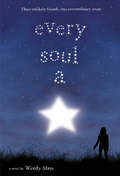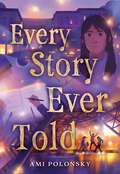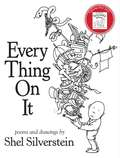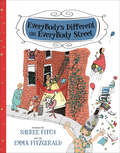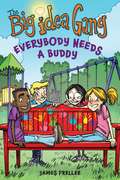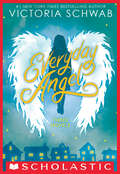- Table View
- List View
Everblaze: Exile; Everblaze; Neverseen; Lodestar (Keeper of the Lost Cities #3)
by Shannon MessengerA New York Times bestselling series A USA TODAY bestselling series A California Young Reader Medal–winning series Sophie uncovers shocking secrets—and faces treacherous new enemies—in this electrifying third book in the Keeper of the Lost Cities series.Sophie Foster is ready to fight back. Her talents are getting stronger, and with the elusive Black Swan group ignoring her calls for help, she’s determined to find her kidnappers—before they come after her again. But a daring mistake leaves her world teetering on the edge of war, and causes many to fear that she has finally gone too far. And the deeper Sophie searches, the farther the conspiracy stretches, proving that her most dangerous enemy might be closer than she realizes. In this nail-biting third book in the Keeper of the Lost Cities series, Sophie must fight the flames of rebellion, before they destroy everyone and everything she loves.
Everblaze: Keeper Of The Lost Cities; Exile; Everblaze; Neverseen; Lodestar (Keeper of the Lost Cities #3)
by Shannon MessengerSophie uncovers shocking secrets—and faces treacherous new enemies—in this electrifying third book in the Keeper of the Lost Cities series. Sophie Foster is ready to fight back. Her talents are getting stronger, and with the elusive Black Swan group ignoring her calls for help, she&’s determined to find her kidnappers – before they come after her again. But a daring mistake leaves her world teetering on the edge of war, and causes many to fear that she has finally gone too far. And the deeper Sophie searches, the farther the conspiracy stretches, proving that her most dangerous enemy might be closer than she realizes. In this nail-biting third book in the Keeper of the Lost Cities series, Sophie must fight the flames of rebellion, before they destroy everyone and everything she loves.
Everlasting Nora: A Novel
by Marie Miranda CruzAn uplifting young reader debut about perseverance against all odds, Marie Miranda Cruz's debut Everlasting Nora follows the story of a young girl living in the real-life shantytown inside the Philippines’ Manila North Cemetery.After a family tragedy results in the loss of both father and home, 12-year-old Nora lives with her mother in Manila’s North Cemetery, which is the largest shantytown of its kind in the Philippines today.When her mother disappears mysteriously one day, Nora is left alone.With help from her best friend Jojo and the support of his kindhearted grandmother, Nora embarks on a journey riddled with danger in order to find her mom. Along the way she also rediscovers the compassion of the human spirit, the resilience of her community, and everlasting hope in the most unexpected places.“Heartwarming!”—#1 New York Times Bestselling Author Melissa de la Cruz“A story of friendship and unrelenting hope.”—Newbery Medalist Erin Entrada KellyAt the Publisher's request, this title is being sold without Digital Rights Management Software (DRM) applied.
Evertaster (Evertaster Series #Book 1)
by Adam Glendon SidwellWhen eleven year-old Guster Johnsonville rejects his mother's casserole for the umpteenth time, she takes him into the city of New Orleans to find him something to eat. There, in a dark, abandoned corner of the city, they meet a dying pastry maker who tells them of a legendary recipe called the Gastronomy of Peace -- a recipe created hundreds of years ago, sought after by connoisseurs everywhere, and rumored to be so delicious that whoever tastes it will never want to eat anything else again. Guster thinks this might be just what he needs -- until the ruthless Gastronimatii, a cult of armed and sinister chefs -- attack the Johnsonvilles. Guster, his sister Mariah, his mother Mabel, and his two brothers are forced to flee for their lives and set out across the world in search of the One Recipe’s ingredients. On an adventure that will take them to ancient ruins, magical beasts, faraway jungles, and forgotten caves, the Johnsonvilles must unravel the mystery behind the One Recipe.
Evertaster: The Delicious City (Evertaster Series #2)
by Adam SidwellWhen a strange little man dressed as a Conquistador comes clattering into the barn at the back of the Johnsonville farmhouse one night, Guster is forced to face the truth: he is now the most delicious thing in the whole world, and something terrible is coming to eat him. When Guster runs away from home in an attempt to elude the monster, he is kidnapped and taken to a city in a far corner of the Himalayas where he discovers a city made of pure ice cream. Now, with the monster returning soon, and the Mayor of the City determined to feed Guster to the beast at all costs, Guster must take courage in order to save the collapsing city and his family.
Every Body Wonderfully Made: God's Good Plan for Boys and Girls
by Courtney SiebringBoy or girl? Tall or short? Every Body Wonderfully Made shows how every detail was planned with purpose by our loving Creator. "You are great, God, and my body is, too! Help me use it for goodness, beauty, and truth." Motivated by Psalm 139, this book tells of the incredible delight that each human is lovingly crafted by God, fearfully and wonderfully made. Through imaginative illustrations, lovable characters, and playful language, children can celebrate the wonderful miracle of their bodies. Every Body Wonderfully Made speaks directly to each child about their worth, purpose, and uniqueness in the eyes of the Creator. Every child has amazing opportunities to experience life, creation, beauty, and love. Every Body Wonderfully Made encourages children ages 3 to10 in their identity—boy or girl—from a biblical point of view. Paired with rich, colorful illustrations that assist early readers in understanding sophisticated concepts, Every Body Wonderfully Made teaches children about the goodness of their loving heavenly Father, who created them on purpose with purpose in their beautiful bodies. Every Body Wonderfully Made: Is the perfect book for boys and girls ages 3–10 to learn about just how much they are worth in the eyes of God. Makes a wonderful gift for baby showers, birthdays, and elementary/preschool graduations. Provides parents, grandparents, and caregivers a wonderful narrative to help explain the dignity, worth, and beauty of each child from a God-centered perspective. Is a valuable resource for homeschooling families, librarians, children's ministers, Sunday school teachers, and Christian school educators. Every Body Wonderfully Made lovingly cups each child's chin, looks deeply into their eyes, and says, "You were made on purpose with purpose." It affirms to children's hearts that their bodies –male or female– are inextricably linked to their personhood. We are God's workmanship. —Courtney Siebring, Author.
Every Day After
by Laura GoldenIt's been two months since Lizzie's daddy disappeared due to the awful Depression. Lizzie's praying he'll return to Bittersweet, Alabama, for her birthday. It won't feel special without him, what with Lizzie's Mama being so sad she won't even talk and the bank nipping at their heels for a mortgage payment.Daddy expected her to be the best at any cost. But Lizzie claims "that cost me my top grades and my best friend. It's dumped 'em both square into Erin's hands. She's gone batty if she thinks she's gonna get me carted off to the orphanage."While Lizzie waits, she gets comfort writing in her journal. As time passes, she can only picture her daddy's face by opening her locket. If others can get by, why did her daddy leave? If he doesn't return, how can she overcome the same obstacles that drove him away?
Every Day on Earth: Fun Facts That Happen Every 24 Hours
by Matthew Murrie Steve Murrie Tom BloomDiscover all of the amazing things that can happen around the world in just one day! You already know all of the amazing things that can happen in just one minute on Earth, so think of what could happen in a whole day! Your taste bud cells are replaced at a rate of 50,000 a day. Almost 40,000 trees are cut down every day just to make paper bags. And a mayfly lives its entire life in a single day. This book is full of fun facts about space, technology, pop culture, food, animals, sports, the human body, and more!
Every Last Drop: Bringing Clean Water Home (Orca Footprints)
by Michelle MulderIn the developed world, if you want a drink of water you just turn on a tap or open a bottle. But for millions of families worldwide, finding clean water is a daily challenge, and kids are often the ones responsible for carrying water to their homes. Every Last Drop looks at why the world's water resources are at risk and how communities around the world are finding innovative ways to quench their thirst and water their crops. Maybe you're not ready to drink fog, as they do in Chile, or use water made from treated sewage, but you can get a low-flush toilet, plant a tree, protect a wetland or just take shorter showers. Every last drop counts!
Every Minute on Earth: Fun Facts that Happen Every 60 Seconds
by Matthew Murrie Steve MurrieDiscover all of the amazing things that can happen around the world in just one minute! In the minute it could take you to read this page, the Earth will be hit by 6,000 lightning strikes; 2,137 pounds of popcorn will be eaten; 10,000 pieces of skin will be lost from your body; 21,000 pizzas will be baked; 954 camera phones will be sold worldwide; the International Space Station will travel 289 miles in its orbit around the Earth; and 750,000 gallons of water will tumble over Niagara Falls. The Earth and its inhabitants are active every minute of the day. Isn't it amazing what can happen in such a short amount of time?
Every Missing Piece
by Melanie ConklinMaddy Gaines sees danger everywhere she looks: at the bus stop, around the roller rink, in the woods, and (especially) by the ocean. When Maddy meets a mysterious boy setting booby traps in the North Carolina woods, she suspects the worst. <P><P>Maddy is certain she's found Billy Holcomb-the boy who went missing in the fall. Except, maybe it's not him. It's been six months since he disappeared. And who will believe her anyway? Definitely not her mom or her stepdad . . . or the chief of police. <P><P>As Maddy tries to uncover the truth about Billy Holcomb, ghosts from her own past surface, her best friend starts to slip away, and Maddy's world tilts once again. Can she put the pieces of her life back together, even if some of them are lost forever?
Every Single Second
by Diana Sudyka Tricia SpringstubbFrom acclaimed author Tricia Springstubb comes a poignant and topical middle grade novel about the effects of an accidental shooting on family, friendship, and community. Perfect for fans of Jennifer L. Holm and Rita Williams-Garcia.Twelve-year-old Nella Sabatini's life is changing too soon, too fast. Her best friend, Clem, doesn't seem concerned; she's busy figuring out the best way to spend the "leap second"--an extra second about to be added to the world's official clock. The only person who might understand how Nella feels is Angela, but the two of them have gone from being "secret sisters" to not talking at all.Then Angela's idolized big brother makes a terrible, fatal mistake, one that tears apart their tight-knit community and plunges his family into a whirlwind of harsh publicity and judgment. In the midst of this controversy, Nella is faced with a series of startling revelations about her parents, friends, and neighborhood. As Angela's situation becomes dangerous, Nella must choose whether to stand by or stand up. Her heart tries to tell her what to do, but can you always trust your heart? The clock ticks down, and in that extra second, past and present merge--the future will be up to her.
Every Soul a Star (Little Brown Novels)
by Wendy MassThree middle schoolers are brought together at Moon Shadow, an isolated campground where thousands have gathered to catch a glimpse of a rare and extraordinary total eclipse of the sun. Ally's parents own Moon Shadow, where she's lived pretty much her entire life. When her parents tell her they're moving away to the city, she's suddenly frightened of the world beyond the campgrounds and desperately wants to stay at the only home she's ever known. Bree is popular, gorgeous, and on her way to becoming homecoming queen (when she gets to high school). With scientist parents and a brainiac little sister, Bree is the black sheep of the family. When her parents break it to her that they're moving to Moon Shadow, Bree realizes that popularity doesn't mean a thing when there's no one there to see it. Overweight and awkward, Jack is confused when his science teacher asks him to go on a trip to view the eclipse at Moon Shadow, especially since he failed science class. Although this is a chance for Jack to make up for his failure and bypass summer school, it also gives him the courage to come out of his shell and find true friends for the first time. Told from these three perspectives, Wendy Mass weaves an intricate and compelling story about strangers coming together under different circumstances and establishing unlikely friendships. With breathtaking descriptions of nature and its ultimate phenomenon, the eclipse, Every Soul a Star is a powerful and humorous story about dealing with change and discovering one's place in the universe.
Every Story Ever Told
by Ami PolonskyIn this life-affirming novel of trauma and recovery, a girl searches for a path forward after being forced to confront the reality of gun violence, for fans of Dusti Bowling and Jasmine Warga. Stevie Jane Cohen-Kaplan&’s sheltered suburban life is shattered by a mass shooting at a festival in her town. In the aftermath, her brain feels broken. She can&’t bear to visit her mom, recovering in the hospital under Stevie&’s dad&’s watchful eye, or to be pent up in her grandparents&’ nearby Manhattan apartment. To escape the apartment and her own thoughts, Stevie starts adventuring around New York City with her best friend, Avi, and a new therapy dog (in training). The trio starts chasing stories—about a neighbor&’s life after the Holocaust, Stevie&’s grandfathers who died of AIDS long before she was born, and even about her own mom&’s activist upbringing. These stories may not bring Stevie all the way back to &“normal,&” but can they help her find a new version of herself? Written with compassion and care, Every Story Ever Told places readers at the center of their own story and within a larger human tapestry, as one girl tries to make sense of the unthinkable.
Every Thing on It
by Shel SilversteinHave you ever read a book with everything on it? Well, here it is, an amazing collection of never-before-published poems and drawings from the creator of Where the Sidewalk Ends, A Light in the Attic, and Falling Up. You will say Hi-ho for the toilet troll, get tongue-tied with Stick-a-Tongue-Out-Sid, play a highly unusual horn, and experience the joys of growing down. What's that? You have a case of the Lovetobutcants? Impossible! Just come on in and let the magic of Shel Silverstein bend your brain and open your heart.
EveryBody's Different on EveryBody Street
by Sheree FitchThe award-winning poet and author of Summer Feet offers delightful rhyming picture book that helps children embrace diversity. If ever you go travellingOn EveryBody StreetYou'll see EveryBody&’s DifferentThan EveryOne you meet Sheree Fitch&’s playful words lead you into this beautiful children's book and invite you to celebrate our gifts, our weaknesses, our differences, and our sameness. Fitch displays her wit and mastery of words in quick, rollicking rhymes that are complemented by Emma FitzGerald&’s lively illustrations. EveryBody&’s Different on EveryBody Street was originally produced in 2001 as a fundraiser to commemorate the 10th Anniversary of the Festival of Trees in support of the Nova Scotia Hospital and to raise awareness for mental illness and addiction. &“With a style reminiscent of Quentin Blake, FitzGerald&’s illustrations of people letting their freak flag fly complement Fitch&’s exuberant, playful, and poignant rhymes.&” ―Quill & Quire (Toronto, ON) &“Fitch&’s lyrical prose is enhanced by the very beautiful illustrations of Emma FitzGerald. The illustrations are done in bold and bright colors, and are very rich in detail which provides a superb backdrop for this poem about individual differences.&” ―Canadian Materials Magazine
Everybody Needs a Buddy (The Big Idea Gang)
by James PrellerThe Big Idea Gang is buddying up on a new idea for a more welcoming playground in this chapter book series about making a case—and making a difference. When third-graders Deon, Kym, Lizzy, and Connor formed the Big Idea Gang, their mission was simply to oust the old mascot in favor of something cooler. But sales from the new mascot paraphernalia have led to extra cash for the PTA, and you can bet this gang has big ideas about how to spend it. A playground pirate ship! An author visit! New basketball hoops! There are lots of ways they can think of to improve their school; but what about a way to make it a kinder, more inclusive place? Luckily, their teacher, Miss Zips, is skilled in the art of persuasion. Armed with Miss Zips's persuasive tips, the Big Idea Gang sets out to build a case for a new-and-improved Clay Elementary, and convince the rest of the school that their idea is the best.
Everybunny Loves Magic (The Incredibly Dead Pets of Rex Dexter #3)
by Aaron ReynoldsFrom #1 New York Times bestselling author Aaron Reynolds comes the third hilariously macabre mystery in The Incredibly Dead Pets of Rex Dexter series.My name is Rex Dexter. Yes. THAT Rex Dexter. The one cursed with the ability to see and talk to dead animals. The solver of atrocities against the four-footed. The savior of the flipper-finned. Save your standing ovation for later, because I have bigger things on my mind. Rabbits. Specifically, dead rabbits. And not just anybunny. This particular gaggle of rabbits once belonged to the Astounding Isabel, Middling Falls&’ foremost birthday party magician. One thing has quickly become clear…somebunny hates magic. Whoever it is, they&’re attempting to put the Astounding Isabel out of the birthday biz for good. And they&’re willing to whack a whole lotta bunnies to do it. It&’s a cold cruel world out there. But don&’t worry. I&’m on the case. And so is Darvish. And Drumstick. And possibly several dozen rabbits. The point is, nobunny pulls one over on Rex Dexter…and his best friend…and his dead chicken.Nobunny.
Everyday Angel: Three Novels (Everyday Angel #2)
by Victoria Schwab V. E. SchwabFrom #1 New York Times bestselling author Victoria Schwab, three whimsical and enchanting novels about a quirky and clever guardian angel, and the girls she's sent to help, in one irresistible volume.Aria Blue seems like an ordinary twelve-year-old. She loves music, and colorful shoelaces, and taste-testing various types of cookies. But there is much more to Aria than meets the eye. She can use her shadow like a door to travel from place to place. She can dream things into existence. And she can see when certain people need help.Because Aria is a guardian angel. Her mission? To find and guide three different girls -- Gabby, Caroline, and Mikayla -- through their different problems. If she succeeds, Aria will earn her wings. But helping these girls is no easy feat, even for someone with magic powers. Things like friendship and family and well, life, are all a lot trickier than Aria might have guessed. Still, she's pretty sure she's up for the challenge . . .Meet a magical girl like no other, from an author like no other, in this one-of-a-kind collection.
Everyday Editing: Inviting Students to Develop Skill and Craft in Writer's Workshop
by Jeff AndersonEditing is often seen as one item on a list of steps in the writing process, usually put somewhere near the end, and often completely crowded out of writer' s workshop. Too many times daily editing lessons happen in a vacuum, with no relationship to what students are writing. In Everyday Editing , Jeff Anderson asks teachers to reflect on what sort of message this approach sends to students. Does it tell them that editing and revision are meaningful parts of the writing process, or just a hunt for errors with a 50/50 chance of getting it right,comma or no comma? Instead of rehearsing errors and drilling students on what' s wrong with a sentence, Jeff invites students to look carefully at their writing along with mentor texts, and to think about how punctuation, grammar, and style can be best used to hone and communicate meaning. Written in Jeff' s characteristically witty style, this refreshing and practical guide offers an overview of his approach to editing within the writing workshop as well as ten detailed sets of lessons covering everything from apostrophes to serial commas. These lessons can be used throughout the year to replace Daily Oral Language or error-based editing strategies with a more effective method for improving student writing.
Everyday Hero
by Kathleen CherryWhen a new friend challenges Alice, who has Asperger's, to step outside her comfort zone, Alice decides to revise her rules in this novel for middle readers.
Everyday Magic for Kids: 30 Amazing Magic Tricks That You Can Do Anywhere
by Justin FlomPerfect the art of magic with simple every day objects and tips from professional magician Justin Flom.Using every day objects, daring magician Justin Flom (434K Facebook followers and 153K subscribers on YouTube) will teach kids all they need to know to perform 30 amazing and how-did-you-do-that magic tricks at the turn of a hat. Featuring step-by-step instructions and illustrations, Everyday Magic for Kids will give budding magicians all the tips they need in order to wow their friends and family, whether at home, at school, or on the go. Tricks will vary from card tricks to tricks with coins and other small objects to tricks that can be done with friends/family members. The book also includes introductory material about how to act like a magician and the basics of performing magic in front of an audience (be it a friend or a room of people).
Everyday Math
by RemediaMath plays a vital role in everyone's life on a daily basis and in a variety of situations. Everyday Math presents 27 different kinds of ordinary activities where math is needed to find answers to questions about the activity.
